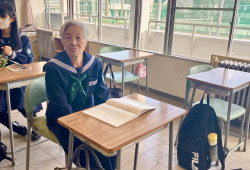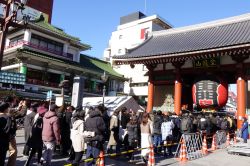
July 17, 2008
Dressed to Thrill
As the summer sizzles with major cosplay events across Japan, the industry branches out in bold new directions
By Metropolis
Originally published on metropolis.co.jp on July 2008

Photos by Adrian A. Lozano
The young bureaucrat from Aichi Prefecture in central Japan straightens the starched collar under his smart black suit and states his business to the editors of Akiba Keizai Shimbun, Tokyo’s leading geek periodical.
“I have come to learn about cosplay,” he says. “This is the future of our region.”
The scene is an increasingly common one as costumed role-playing emerges from the otaku realm and into the global spotlight of fashion and art. Japanese businesses, politicians and fans alike are struggling to get a handle on a hobby valued at some $350 million annually, one that has fueled the establishment of a national association, Cos-Most, as well as the World Cosplay Summit in Aichi. Comike, Japan’s largest public cosplay gathering, draws 500,000 visitors and 14,000 cosplayers, many of whom attend events throughout the year in anticipation.
A large percentage of cosplayers know one another from massive online networks and communities. Cure, Japan’s largest cosplay social-networking site, has 270,000 registered users and attracts up to 200 new members a day. Around 200,000 are non-posting members just there to cruise the photos. Some 90 percent of cosplayers are women, the majority in their teens and 20s. According to a survey by research firm Broach, 46.8 percent of women between the ages of 20 and 40 want to try cosplay, and 18.9 percent have already done it.
The subculture has also spawned its own lingo. To share ideas, exchange photos, and mix with likeminded practitioners, some cosplayers attend private parties known as cospa and dance events called danpa. Fans who take photos rather than pose in costume are known as kamekozo, or “camera kids,” and support amateur cosplay idols with free pictures and publicity. Conversely, dedicated reiyaas, or hardcore cosplayers, form clubs to make friends, produce their own costumes and organize gatherings.
Naoki Shimohashi from Gunma met his wife Maki cosplaying—in fact, they were married wearing their own handmade clothes. Sewing costumes and maintaining the hundreds of outfits in their private wardrobe is a hobby the couple enjoy together, and one they spend tens of thousands of dollars pursuing.
“The appeal is becoming characters you love from the series you love and wearing outfits you could never normally wear,” Shimohashi says. “Every time you cosplay, you can meet a new self.” Experts tend to agree.
“There is a ritualistic element to cosplay that puts wearers in a different state of mind,” said Philomena Keet, 27, who received her doctorate in anthropology from London University after studying Tokyo fashion for seven years. “Wearing costumes isn’t about rebellion or fame-seeking, but a readymade sociality in groups of people with similar interests they embody in cosplay.”
Thanks to the organic community system, professional cosplayers have emerged, including the prolific Yunmao Ayakawa.

“It’s a very good time in the history of cosplay because there are fewer people harboring prejudice,” says the 23-year-old, who has been cosplaying for over 10 years and now regularly appears on TV. “I think people have started to accept cosplay as a fun and interesting culture.”
Pointing to overseas customs such as the masquerade and Halloween, Ayakawa claims that cosplay is a “natural” extension of a global phenomenon. “Cosplay is part of a shared culture that is now enjoyed by otaku in all the countries of the world,” she says.
The figures back her up. Cosplay conventions in France, Germany and Italy draw up to 85,000 people, while Anime Expo in LA claims 41,000 visitors, most of whom cosplay and organize stage shows and competitions of a kind not found in more passive Japanese events.
“The cosplay scene is still a subculture in the US without media or public support,” says “Steph,” a cosplay talent who was named Anime Expo Idol in 2004. “The cosplay scene in Japan is incorporated daily into the lives of many people in places such as Harajuku and Akihabara.”
Indeed, Akihabara is infamous for its maid cafes and Sunday cosplaying (and “crossplaying” as characters of the opposite sex), boasting no fewer than six stores selling anime-inspired costumes. While most Japanese cosplayers are craftspeople preferring to sew their own costumes of minor, personally beloved characters, newer fans and visitors from abroad have created a market ripe for mass dissemination.
This has provided a boon to companies like Cospa, Japan’s first professional cosplay tailor. Founded in Akihabara in 1995 and now operating out of Shibuya, Cospa is looking to expand its annual $18 million empire across the globe. Costumes bearing the company’s Cospatio label—or any premium costume in Japan for that matter—start at around ¥50,000. Stylish jackets, pants and boots are around ¥30,000 each, and full custom cosplay can cost several thousand dollars.
But foreigners, like Japanese, seem increasingly willing to pay these prices. The largest English-language cosplay site, Cosplay.com, has 101,400 members and is expected to grow by another 55,000 this year. According to a 2007 NHK survey, about 87.5 percent of foreigners think Japanese cosplay is cool.
“Cosplay is far more respected abroad as a form of self-expression,” says Akio Tahara, managing editor of Josei Jishin, a popular gossip magazine that has recently run articles on foreigner involvement in cosplay. “I think they see Japanese as homogenous and boring, so foreigners are moved when someone steps out and shows individuality.”
“For foreigners, cosplay is a carnival that allows freedom of expression,” agrees Atsuhisa Okura, 39, the award-winning author of the manga Moe USA, which looks at foreigners in Akihabara. “Japanese have liked matsuri, or festivals, for a long time, but now foreigners are coming to understand those joys.” So many foreigners are now cosplaying here that a group of Japanese, along with expat partners, decided in 2007 to found Cosplish, a school that teaches “cosplay English” to assist cross-cultural communication.
“Cosplish’s style is out of box, moving the focus off how well you speak English and onto your interests,” says Mimmi Schwalbe, 20, a Swedish national who cosplays in a Gundam uniform when teaching.
“We create a better atmosphere, have fun and learn English you can actually use.”
Class sizes and offerings vary, but popular choices include Maximal Broken English; a course on online chat speech; and discussion and translation of anime both domestic and foreign. The range of students is impressive, including both otaku and non-otaku men and women who are usually students or company employees.
“We’re all so different and live very different lives, but can connect and be friends on this level,” says Mimmi.
Other companies are following suit. On the heels of a cosplay fashion show at Roppongi Hills last year, Vantan, one of Japan’s largest and most respected fashion schools, started a professional “Cosplay Course.”
“We saw the appeal abroad and how well related businesses were doing in Japan, so we decided to lend our expertise to the new generation of cosplayers,” says Michiko Nakano, a Vantan spokeswoman. “Most of the students are full-time workers or students elsewhere who commute here to sharpen their cosplay skills. It is still largely just a hobby, but I expect our graduates can find work as tarento and models.”
The three-month “Fun” course consists of lessons in costume making, hair and makeup, photo techniques and retouching, constructing swords and accessories, and a follow-up lesson on fashioning costumes. The price is about ¥53,000; the “Expert” course is six months and costs over ¥85,000.
Vantan is drawing attention with its innovative program and will be featured prominently by H.I.S. Experience in their tour to the 6th Annual World Cosplay Summit in Aichi.

“Japan is not just temples and tea ceremonies, but a vibrant pop-culture,” says tour planner Shoji Hayashi, 32, taking time out from singing anime theme songs at Karaoke Tetsujin in Shinjuku. “This tour is a festival, and we all want to participate. I say ‘Don’t be shy!’ and don my cosplay and invite others to join me.”
Hayashi, along with all the 30 or so cosplaying tour members, will attend the Vantan course, walk the streets of Akihabara and Harajuku, ride the bullet train, parade on the streets of Nagoya in Aichi and, finally, attend the World Cosplay Championship, which pits contestants from 13 countries against one another and draws some 10,000 cosplaying spectators.
“Japan has some of the best cosplayers in the world because they want to kiwameru, or deepen their craft and go far beyond the norm,” Hayashi says. “This is an aspect of traditional Japanese culture that I see reflected in otaku culture, especially cosplay. Cosplay and its artisans have soul and go beyond limits to make fantasy a reality.”
He and his colleagues hope Vantan will help foreigners enjoy cosplay more deeply.
“We are doing this tour in answer to the many requests we have received from overseas, especially from Germany,” said Yukie Okama, 38, a liaison for H.I.S.’s weekly cosplay tour in Akihabara. Indeed, Germany is a key player in the global scene, hosting the German Cosplay Championship. It is widely rumored that the Japanese Ministry of Foreign Affairs supports the World Cosplay Summit in Aichi so that Japan, the supposed birthplace of cosplay, does not fall behind in recognizing and awarding the art before a foreign authority scoops them—as happened with anime after Miyazaki Hayao’s Spirited Away won best animated film at the 2002 Academy Awards.
“Manga, anime and cosplay are exports Japan can take pride in,” says Katsuhito Asano, the vice foreign minister who attended last year’s Summit. “These are things that draw good feelings about Japan from the people of the world.”
For their part, cosplayers take more pride in their hobby as a way to enjoy to international exchange than soft-power domination.
“Cosplay is part of a shared culture that is now enjoyed all over the world,” says Ayakawa, who has made it her mission to visit every cosplay convention across the globe. “I want to work as a cosplaying missionary, spreading the joy of cosplay to Japan and the world. If music is a common culture that can move the hearts of people and unite the world in peace, I think cosplay is also a wonderful tool.”
World Cosplay Summit
2008 An international gathering of the world’s best cosplayers under the banner “Japan is cool,” the World Cosplay Summit is held in Aichi. Since its humble beginnings in 2003, it now consists of a 200-member costume parade through the Osu Kannon area of Nagoya and the World Cosplay Championships, which pits the top talents from 13 countries against one another and draws some 10,000 cosplaying spectators.
August 2-3. See www.tv-aichi.co.jp/wcs for details.
Comike
Japan’s largest doujinshi, or amateur fan-produced manga sales event, is held twice a year at Tokyo Big Sight in Odaiba. Admission is free. There is a terrace and separate halls where thousands of cosplayers strut their stuff and pose for pictures.
August 15-17. See www.comiket.co.jp/index_e.html for details.
Cospa
Japan’s first, largest and most successful professional costume maker specializes in anime cosplay characters, which it has exclusive rights to make and sell. The original showroom, opened in 1995 below Japan’s first maid café in Akihabara, is a trove of costumes and apparel.
2F & 5F, 3-15-5 Gee Store Akihabara, Soto-Kanda, Chiyoda-ku. Open daily 11am-8pm. Tel 03-3526-6877. Nearest stn: Akihabara. www.cospa.com/qa_detail/id/27
Vantan Career School
One of Japan’s oldest and most respected vocational schools, Vantan specializes in fashion and has eight locations across Japan, including Shibuya and Ebisu. Its Cosplay Course caters to practitioners and helps them professionalize their creative hobbies.
3-1-8 Ebisu-Minami, Shibuya-ku. Tel: 0120-422-550. Nearest stn: Ebisu. http://vantan.costype.net/
Karaoke Tetsujin
In addition to being the cheapest karaoke ticket in Tokyo, Karaoke Tetsujin is famous for offering rental costumes to wear while singing.
3F, 1-21-2 Kabukicho, Shinjuku-ku. Tel: 03-5155-9061. Open daily 11am-6am. Nearest stn: Shinjuku, east exit. www.karatetsu.com/tenpo/shinjyuku
Cosplish
This school for “cosplay English” uses anime viewing and discussion. Cosplayers from around the world gather in Akihabara and attempt to bridge the language gap with the power of shared pop culture. Classes cost around ¥1,200 an hour and are offered infrequently.
See the (Japanese) website for more details. Sonpo Kaikan, 2-9 Kanda-Awajicho, Chiyoda-ku. Nearest stn: Akihabara or Ochanomizu. http://cosplish.seesaa.net
Cos-Most
Founded in August 2007, this SNS has quickly grown into one of the largest and most active community sites in Japan, with approximately 15,000 users and 4 million page views a month. It organizes cospa (small cosplay parties) and larger events such as Halloween masquerades.
See http://cos-most.com for more information.
Cosplay Summit Special Tour
Travel group H.I.S. Experience will conduct an all-inclusive tour of the World Cosplay Summit in Aichi. About 30 participants will attend the Vantan course (see main text), walk the streets of Akihabara and Harajuku, parade in Nagoya, and attend the World Cosplay Championship. The tour begins July 30 and runs through August 5. The cost is about ¥98,000 but cheaper for locals who don’t need accommodations.







